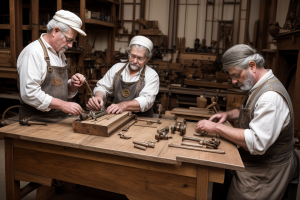
Craftsmanship refers to the skill and artistry that goes into creating something by hand. It’s the ability to take raw materials and turn them into a finished product that is both functional and aesthetically pleasing. When someone is said to have good craftsmanship, it means that they possess a high level of skill and attention to detail in their work. This can be seen in a variety of fields, from woodworking and metalworking to cooking and baking. In this guide, we will explore what it means to have good craftsmanship and how it can impact the quality of a finished product.
Understanding Craftsmanship
Defining Craftsmanship
Craftsmanship in Context
Craftsmanship refers to the skill and expertise required to create a product or service that meets a high standard of quality. It encompasses a wide range of activities, from traditional trades such as carpentry and blacksmithing to modern industries like software development and graphic design.
Historical Significance
Craftsmanship has a long and rich history, dating back to ancient civilizations where skilled artisans created beautiful and functional objects using simple tools and materials. Over time, craftsmanship evolved to include more complex techniques and technologies, but the fundamental principles of quality, craftsmanship, and attention to detail remained constant.
Cultural Significance
Craftsmanship is also deeply rooted in cultural traditions and values. In many societies, craftsmen were highly respected for their knowledge, skill, and dedication to their craft. Their work was often considered a form of art, and many craftsmen were commissioned to create unique and special objects for royalty, religious institutions, and other prominent figures.
The Craftsman’s Mindset
To understand the meaning of good craftsmanship, it is important to understand the mindset of a craftsman. Craftsmen possess a unique combination of technical expertise, creativity, and passion for their work. They approach their craft with a deep sense of commitment and pride, striving for excellence in every aspect of their work.
Attention to Detail
Attention to detail is a hallmark of good craftsmanship. Craftsmen pay close attention to every aspect of their work, from the choice of materials to the smallest details of construction and finish. They are meticulous in their work, striving for perfection in every aspect of their craft.
Passion and Pride
Passion and pride are also essential elements of good craftsmanship. Craftsmen are deeply committed to their work and take great pride in their craft. They are driven by a desire to create beautiful and functional objects that will stand the test of time.
Continuous Learning
Finally, good craftsmanship requires a commitment to continuous learning. Craftsmen are always seeking to improve their skills and knowledge, experimenting with new techniques and materials, and exploring new ideas and approaches. They are always open to new ideas and willing to learn from others, constantly striving to push the boundaries of their craft.
Evaluating Craftsmanship
Assessing Quality
When evaluating craftsmanship, there are several factors to consider in determining the quality of a product. These include:
Techniques and Materials
The techniques and materials used in creating a product can greatly impact its overall quality. High-quality craftsmanship often involves the use of skilled techniques and premium materials. For example, a woodworker may use a combination of hand-carving and sanding techniques to create a beautiful piece of furniture, while a jeweler may use high-quality diamonds and precious metals to create a stunning piece of jewelry.
Consistency and Reliability
Consistency and reliability are also important factors to consider when evaluating craftsmanship. A product that is consistently well-made and reliable is often a sign of high-quality craftsmanship. For example, a car that is consistently reliable and well-made is likely the result of high-quality craftsmanship.
Durability and Longevity
Durability and longevity are also important factors to consider when evaluating craftsmanship. A product that is well-made and designed to last will often be a sign of high-quality craftsmanship. For example, a pair of shoes that are built to last and can withstand wear and tear is likely the result of high-quality craftsmanship.
The Subjective Nature of Craftsmanship
While there are certain objective factors to consider when evaluating craftsmanship, such as the use of quality materials and techniques, the subjective nature of craftsmanship should not be ignored. Personal preferences, cultural and social factors, and historical context can all play a role in determining what is considered good craftsmanship. For example, a painting that is considered beautiful by one person may not be appreciated by another, and the same can be said for a piece of furniture or a piece of jewelry. Therefore, it is important to consider both objective and subjective factors when evaluating craftsmanship.
The Importance of Good Craftsmanship
Value in Art and Design
Aesthetic Appeal
Good craftsmanship contributes significantly to the aesthetic appeal of art and design. It encompasses various elements that work together to create visual harmony and evoke emotional resonance.
Visual Harmony
- Balance: Good craftsmanship achieves balance in composition, ensuring that the visual elements are distributed evenly and pleasing to the eye.
- Proportion: The use of proper proportions adds to the overall aesthetic appeal, making the artwork or design look harmonious and well-integrated.
- Symmetry: Incorporating symmetry can create a sense of stability and order, contributing to the visual harmony of the piece.
Emotional Resonance
- Authenticity: Good craftsmanship conveys authenticity, allowing the viewer to connect emotionally with the artwork or design on a deeper level.
- Storytelling: Skilled craftsmanship can communicate stories and convey emotions, evoking a strong response from the viewer.
- Imagination: Good craftsmanship sparks the viewer’s imagination, inviting them to engage with the artwork or design on a more profound level.
The Role of Craftsmanship in Sustainability
Environmental Impact
- Material Selection: Skilled craftsmanship involves the careful selection of environmentally friendly materials, reducing the overall environmental impact of the artwork or design.
- Repurposing: Good craftsmanship often involves repurposing existing materials, minimizing waste and promoting sustainable practices.
Social and Economic Benefits
- Local Economies: Good craftsmanship supports local economies by providing employment opportunities and contributing to the preservation of traditional skills and techniques.
- Cultural Preservation: Skilled craftsmanship plays a crucial role in preserving cultural heritage, ensuring that traditional arts and crafts are passed down to future generations.
Exemplary Craftsmanship in Different Fields
Fine Arts
Painting
Brush Techniques
Brush techniques refer to the various ways in which paint is applied to a canvas or surface using a brush. The brush is an essential tool for a painter, and mastery over different brush techniques is crucial for creating a good piece of art. Some of the most common brush techniques include:
- Brushstrokes: This refers to the way in which the brush is moved across the canvas to create different textures and effects.
- Glazing: This technique involves applying thin layers of paint over a previously painted surface to create depth and transparency.
- Impasto: This technique involves applying thick layers of paint to create a raised, textured effect.
Color Theory
Color theory is the study of how colors interact with each other and how they can be used to create different moods and effects in a painting. A good painter must have a thorough understanding of color theory to be able to use color effectively in their work. This includes knowledge of:
- The color wheel: The color wheel is a tool used to show the relationships between different colors. A painter must understand how to mix colors to create different hues and shades.
- Color harmony: This refers to the way in which different colors are arranged in a painting to create a pleasing visual effect.
- Color contrast: This refers to the way in which different colors are used to create a sense of contrast and depth in a painting.
Texture and Composition
Texture and composition are two essential elements of a good painting. Texture refers to the way in which the paint is applied to the canvas to create a sense of depth and dimensionality. A good painter must be able to create different textures using a variety of brush techniques.
Composition refers to the way in which the elements of a painting are arranged to create a cohesive and visually appealing image. A good painter must have a strong understanding of composition to be able to create a painting that is balanced and harmonious. This includes knowledge of:
- The rule of thirds: This is a guideline for arranging elements in a painting to create a sense of balance and visual interest.
- Leading lines: These are lines in a painting that lead the viewer’s eye through the image.
- Focal points: This refers to the main point of interest in a painting, around which the other elements are arranged.
Sculpture
Materials and Tools
The materials and tools used in sculpture play a crucial role in determining the final outcome of a piece. A good sculptor must have a thorough understanding of the properties and limitations of different materials, as well as the tools and techniques used to work with them. Some of the most common materials used in sculpture include:
- Stone: This is a traditional material for sculpture, and is often used for its durability and ability to hold intricate details.
- Metal: Metals such as bronze and steel are often used for their strength and ability to be cast into complex shapes.
- Wood: Wood is a versatile material that can be carved or shaped using a variety of tools.
Form and Function
Form and function are two important elements of a good sculpture. The form of a sculpture refers to its aesthetic appearance, while its function refers to the purpose it serves. A good sculptor must be able to create a sculpture that is both visually appealing and serves a specific purpose. This can include:
- Statues: These are sculptures that are designed to represent a specific person or object.
- Sculptural art: This is a broader category of sculpture that does not necessarily serve a specific function.
- Decorative sculpture: This type of sculpture is designed to add beauty and interest to a space.
Symbolism and Meaning
Symbolism and meaning are important elements of a good sculpture. A good sculptor must be able to create a sculpture that conveys a specific message or meaning. This can include:
- Political statements: Sculptures can be used to express political ideas or opinions.
- Cultural symbols: Sculptures can be used to represent cultural icons or symbols.
- Personal expressions: Sculptures can be used to express personal emotions or experiences.
Architecture
Design Principles
Proportion and Symmetry
Proportion and symmetry are fundamental principles of good craftsmanship in architecture. They refer to the harmonious relationship between different elements of a building, such as its height, width, and length. Architects use these principles to create buildings that are visually appealing and aesthetically pleasing.
Scale and Balance
Scale and balance are also essential design principles in architecture. Architects must ensure that different elements of a building are in proportion to each other and that the building as a whole is balanced. This can be achieved by using different materials, colors, and textures to create a sense of harmony and balance.
Functionality and Aesthetics
Functionality and aesthetics are two more design principles that are essential to good craftsmanship in architecture. Architects must create buildings that are not only visually appealing but also functional and practical. This means considering factors such as the flow of traffic, the placement of doors and windows, and the use of space.
Cultural and Historical Influences
Finally, cultural and historical influences play a significant role in good craftsmanship in architecture. Architects must consider the cultural and historical context of a building and incorporate elements that reflect its history and culture. This can include using traditional building materials, incorporating local motifs and symbols, and preserving historic structures.
Craftsmanship in Modern Architecture
In modern architecture, craftsmanship refers to the skill and expertise involved in creating buildings that are both functional and aesthetically pleasing. This includes using sustainable materials, digital design and fabrication, and innovative techniques to create buildings that are both environmentally friendly and visually stunning.
Sustainable Materials
Sustainable materials are an essential aspect of good craftsmanship in modern architecture. Architects must consider the environmental impact of the materials they use and choose those that are renewable and have a low carbon footprint. This can include using recycled materials, using locally sourced materials, and using materials that require minimal processing.
Digital Design and Fabrication
Digital design and fabrication are also crucial to good craftsmanship in modern architecture. Architects use computer-aided design (CAD) software to create detailed plans and models of their buildings. This allows them to create precise and accurate designs that can be easily modified and refined.
Innovative Techniques
Finally, innovative techniques are an essential aspect of good craftsmanship in modern architecture. Architects must be creative and innovative in their approach to design and construction. This can include using new materials, developing new construction techniques, and incorporating new technologies into their designs.
Craftsmanship in Product Design
Product design encompasses a wide range of objects, from everyday household items to high-end electronics. In this section, we will delve into the specific aspects of craftsmanship in product design and how they contribute to the overall quality of a product.
Material Selection
Material selection is a crucial aspect of product design, as it can greatly impact the functionality, durability, and aesthetic appeal of a product. The following factors should be considered when selecting materials for product design:
Functionality and Durability
Functionality and durability are essential aspects of good craftsmanship in product design. Materials should be chosen based on their ability to perform the intended function and withstand the stresses and strains of everyday use. Factors such as strength, resistance to wear and tear, and ability to withstand environmental conditions should be considered when selecting materials.
Sustainability and Ethical Sourcing
Sustainability and ethical sourcing are increasingly important considerations in product design. Materials should be sourced responsibly and sustainably, taking into account their environmental impact and social implications. This includes choosing materials that are renewable, biodegradable, or recyclable, as well as ensuring that they are sourced from ethical and responsible suppliers.
Aesthetic Appeal
Aesthetic appeal is another key factor to consider when selecting materials for product design. Materials should not only be functional and durable but also visually appealing and pleasing to the touch. Texture, color, and finish are all important considerations when choosing materials for aesthetic appeal.
Design Process
The design process is another critical aspect of good craftsmanship in product design. The following steps should be taken to ensure a well-designed product:
Prototyping and Testing
Prototyping and testing are essential steps in the design process. Prototypes allow designers to test and refine their ideas, ensuring that the final product meets the intended function and user needs. Testing should be done rigorously to ensure that the product is reliable, safe, and effective.
User-Centered Design
User-centered design is a crucial aspect of good craftsmanship in product design. The product should be designed with the user in mind, taking into account their needs, preferences, and behaviors. User research and testing should be conducted throughout the design process to ensure that the final product meets the needs and expectations of its intended users.
Collaboration and Communication
Collaboration and communication are also important aspects of good craftsmanship in product design. Effective communication between designers, engineers, manufacturers, and other stakeholders is essential to ensure that the final product meets the intended specifications and requirements. Collaboration and communication should be fostered throughout the design process to ensure that everyone is working towards the same goal.
Recognizing Good Craftsmanship
Assessing Quality in Fine Arts
Assessing quality in fine arts involves a careful evaluation of various aspects that contribute to the overall aesthetic experience. This section will delve into the specific criteria used to assess quality in painting and sculpture.
Texture and Brushwork
In painting, texture is a critical element that contributes to the visual depth and complexity of the artwork. The texture can be created through the use of different brushwork techniques, such as thick and thin strokes, scraping, and blending. The artist’s ability to create a range of textures and tones is an indicator of their skill and mastery over their medium.
Color Blending and Harmony
Color blending and harmony are essential components of a well-executed painting. A skilled artist should be able to blend colors seamlessly to create a range of hues and shades. Additionally, the use of color should be harmonious and balanced, with a good understanding of color theory and the ability to create a visual rhythm that engages the viewer.
Composition and Balance
Composition and balance are critical factors in determining the quality of a painting. A well-composed painting should have a clear focal point and a sense of balance, with elements arranged in a way that creates visual interest and draws the viewer’s eye to the intended focus. The artist’s ability to create a composition that is both aesthetically pleasing and effective in conveying their intended message is a sign of good craftsmanship.
Material Integrity
In sculpture, material integrity is a crucial aspect of good craftsmanship. The artist should have a deep understanding of the properties and limitations of the materials they are using, and should be able to work with them in a way that highlights their strengths and minimizes their weaknesses. A sculpture that is well-crafted will demonstrate a high level of technical skill and an understanding of the materials used.
The form and function of a sculpture are closely linked, and a well-crafted sculpture will have both aesthetic appeal and functionality. The artist should be able to create a form that is visually appealing and also serves its intended purpose, whether it be to be displayed as a work of art or to serve a practical function.
Emotional Connection
Finally, a well-crafted sculpture should elicit an emotional response from the viewer. A skilled artist should be able to create a sculpture that connects with the viewer on an emotional level, evoking a range of feelings and reactions. The ability to create an emotional connection through sculpture is a sign of a high level of craftsmanship.
Assessing Quality in Architecture
Assessing quality in architecture is a complex process that requires a thorough understanding of design integrity, historical and cultural context, sustainability, and innovation. In this section, we will delve into each of these factors and explore how they contribute to the overall assessment of good craftsmanship in architecture.
Design Integrity
Design integrity is a critical aspect of assessing quality in architecture. It refers to the cohesion and unity of the design elements and how they work together to create a harmonious whole. To assess design integrity, it is important to consider the following factors:
- Cohesion and Unity: A well-designed building should have a cohesive and unified look that ties all the design elements together. This includes the use of consistent materials, colors, and textures throughout the building.
- Historical and Cultural Context: Good architecture should be rooted in its historical and cultural context. It should reflect the local history, culture, and traditions, while also being innovative and forward-looking.
- Sustainability and Innovation: Good architecture should be sustainable and innovative, using materials and technologies that are environmentally friendly and energy-efficient. It should also be adaptable and flexible, able to change and evolve over time.
Craftsmanship in Product Design
Product design is another important aspect of assessing quality in architecture. It refers to the materials and workmanship used in the construction of a building, as well as the innovation and design that go into the building’s features and functions. To assess product design, it is important to consider the following factors:
- Material and Workmanship: The materials and workmanship used in a building can have a significant impact on its quality. High-quality materials, such as natural stone, wood, and glass, can add warmth, texture, and visual interest to a building. Well-crafted details, such as moldings, joints, and finishes, can also enhance the overall quality of a building.
- Innovation and Design: Good product design should be innovative and forward-looking, using new materials and technologies to create unique and functional features. It should also be user-centered, designed to meet the needs and preferences of the people who will use the building.
- User Experience and Functionality: Good product design should create a positive user experience and functionality. It should be intuitive, easy to use, and provide a sense of comfort and well-being to those who use the building.
Overall, assessing quality in architecture requires a holistic approach that considers design integrity, product design, and historical and cultural context. By evaluating these factors, we can gain a deeper understanding of what constitutes good craftsmanship in architecture and how it contributes to the overall quality of our built environment.
Appreciating the Art of Craftsmanship
Aesthetic Pleasure
The aesthetic pleasure derived from good craftsmanship is undeniable. It is the culmination of skill, creativity, and dedication that results in objects of great beauty and appeal. From the intricate patterns of a Persian rug to the delicate lines of a piece of pottery, the visual delight that good craftsmanship offers is a testament to the human capacity for artistry and innovation.
Visual Delight
The visual delight of good craftsmanship lies in the attention to detail and the harmony of form and function. From the graceful curve of a wooden chair to the intricate weaving of a tapestry, the objects created through good craftsmanship are not only practical but also aesthetically pleasing. They are a testament to the artistry and skill of the craftsperson and a reflection of the culture and traditions that have shaped them.
Good craftsmanship also has the power to evoke an emotional connection in the viewer. The sentimental value of an object can be enhanced through the care and skill that goes into its creation. A handmade quilt, for example, can evoke memories of a loved one who made it or the warmth and comfort it provided on cold nights. Similarly, a piece of jewelry crafted with care can become a cherished heirloom, passed down from generation to generation.
Cultural Significance
Good craftsmanship is not only aesthetically pleasing but also carries cultural significance. The objects created through good craftsmanship are often imbued with cultural meaning and can serve as a link to the past.
Historical and Cultural Context
The historical and cultural context in which an object is created can have a profound impact on its significance. A piece of furniture crafted in the 18th century, for example, carries with it the cultural and historical significance of the time period in which it was created. It is a testament to the craftsmanship of a bygone era and can provide insight into the social and economic conditions of the time.
Personal and Collective Meaning
Good craftsmanship can also hold personal and collective meaning for the individuals and communities that create and cherish these objects. A piece of pottery created by a local artisan, for example, can hold personal meaning for the artist who created it and can also become a symbol of pride for the community in which it was created. Similarly, a hand-embroidered dress can be a symbol of cultural identity and heritage for the individual who wears it.
Encouraging and Promoting Good Craftsmanship
Education and Training
- Skill Development: Encouraging individuals to develop their skills and knowledge in their craft is an essential aspect of promoting good craftsmanship. This can be achieved through various means, such as workshops, classes, and apprenticeships. By providing opportunities for individuals to learn and refine their skills, they can create high-quality work that showcases their craftsmanship.
- Knowledge Transfer: It is crucial to transfer knowledge from experienced craftsmen to new and upcoming artists. This transfer can happen through formal and informal means, such as mentorship, apprenticeships, and peer-to-peer learning. By sharing knowledge, craftsmen can learn from each other, and the quality of their work can be improved.
- Apprenticeships and Mentorship: Apprenticeships and mentorship programs provide an opportunity for individuals to learn from experienced craftsmen. This can be an invaluable experience, as it allows the apprentice to gain practical knowledge and hands-on experience in their craft. A mentor can also provide guidance and support, helping the apprentice to develop their skills and knowledge.
Awareness and Advocacy
- Supporting Artisans and Craftsmen: It is important to support artisans and craftsmen by purchasing their products and promoting their work. This support can help to sustain their craft and ensure that their skills are passed down to future generations. By buying products made by skilled craftsmen, consumers can help to promote good craftsmanship and keep traditional crafts alive.
- Promoting Sustainable Practices: Good craftsmanship should also include sustainable practices. This can include using eco-friendly materials, reducing waste, and creating products that are built to last. By promoting sustainable practices, craftsmen can create high-quality work that is also environmentally friendly.
- Raising Public Awareness: It is essential to raise public awareness about the importance of good craftsmanship. This can be achieved through various means, such as exhibitions, festivals, and media coverage. By raising awareness, the public can appreciate the value of good craftsmanship and be more likely to support and purchase products made by skilled craftsmen.
FAQs
1. What is craftsmanship?
Craftsmanship refers to the skill and artistry involved in creating a product or delivering a service. It involves a high level of attention to detail, technical expertise, and creativity. Craftsmanship can be found in various fields, including woodworking, metalworking, textiles, and more.
2. What does it mean if someone has good craftsmanship?
If someone has good craftsmanship, it means that they have developed a high level of skill and expertise in their chosen field. They are able to create products or deliver services that are of a high quality and meet the needs of their customers. Good craftsmanship also involves a strong attention to detail, the ability to problem-solve, and a commitment to continuous improvement.
3. How can I improve my craftsmanship?
Improving your craftsmanship requires dedication, practice, and a willingness to learn. Here are some tips to help you improve:
* Seek out mentors or experts in your field who can provide guidance and feedback.
* Practice regularly to develop your skills and expertise.
* Continuously learn new techniques and technologies to stay up-to-date with industry trends.
* Be open to feedback and willing to make adjustments to improve your work.
* Take pride in your work and strive for excellence in everything you do.
4. What are the benefits of good craftsmanship?
Good craftsmanship can bring many benefits, including:
* Increased customer satisfaction and loyalty.
* Improved reputation and brand recognition.
* Increased productivity and efficiency.
* Greater creativity and innovation.
* Higher quality products or services.
5. Can good craftsmanship be taught?
Good craftsmanship is a combination of natural talent, technical expertise, and learned skills. While some people may have a natural aptitude for certain skills, craftsmanship can be taught and learned through practice and training. Employers can provide training and development opportunities to help employees improve their craftsmanship and develop their skills.







